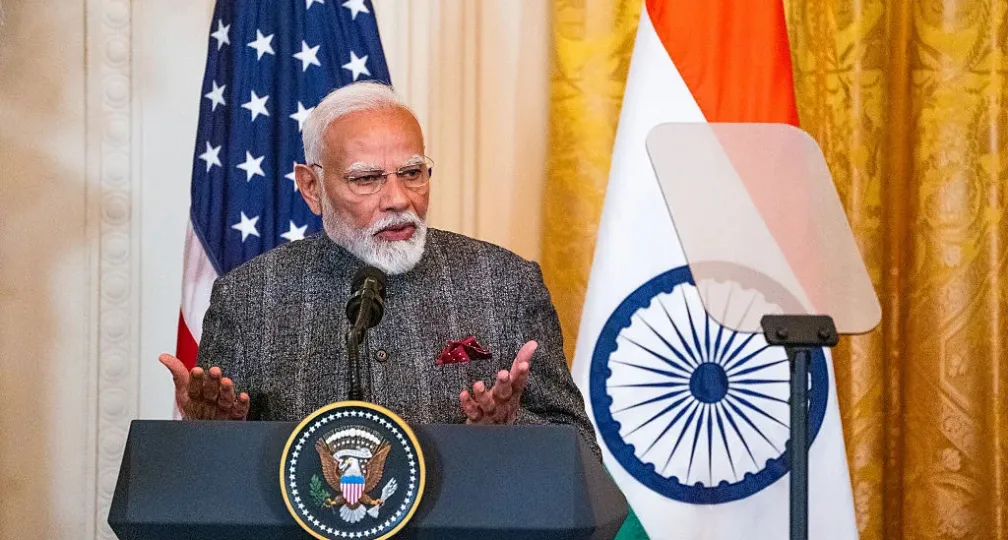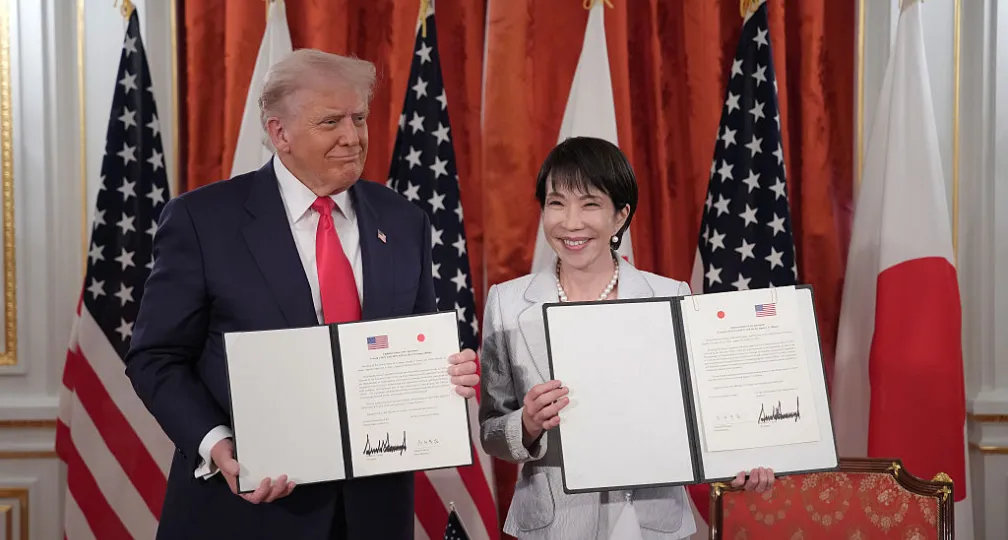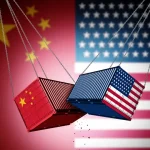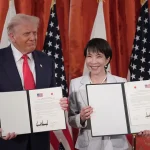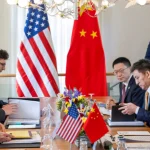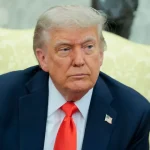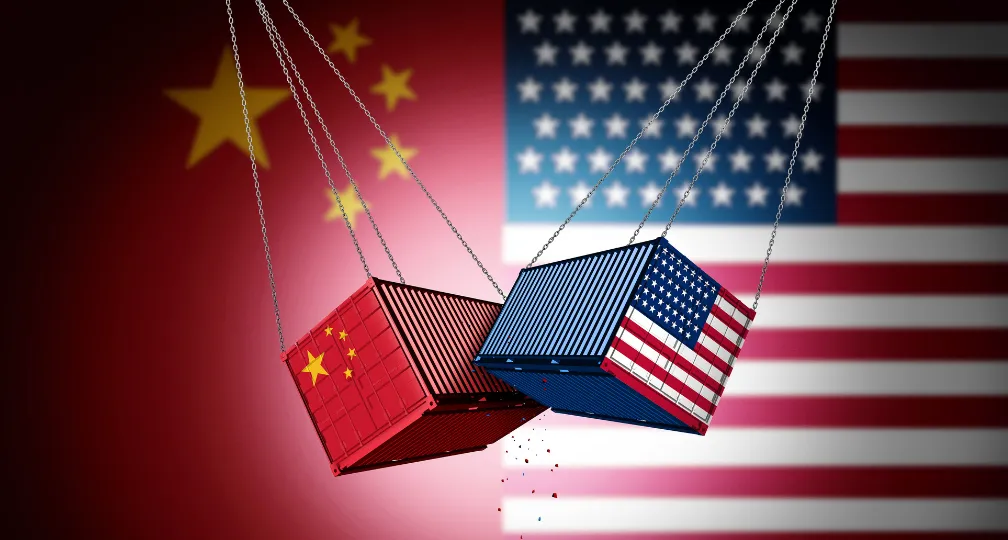Trump 2.0 Diminishes European Union Power

Despite the European Union possessing a far larger domestic market than Japan, in its trade negotiations with the Trump administration the EU only managed to achieve a similar outcome — matching Japan’s tariff level of 15%, listing comparable categories of imports and pledging nearly an equivalent amount of strategic investments.
As Kazuto Suzuki, director of the Institute of Geoeconomics, wrote recently, the geoeconomic weight that a certain country has is a combination of three factors, namely: “strategic autonomy,” “indispensability of goods” and “indispensability of market.”
Yet despite the EU’s large consumer market — historically used for exerting “market power” toward third countries — the political and economic union has failed to fully exercise its strengths since the start of the second Trump administration in January and its global influence has since receded.
Following the end of the Cold War, optimism spread across Europe that declining trade barriers and economic integration would bring stability and prosperity. The 1993 Maastricht Treaty transformed the European Community into the European Union, paving the way toward a unified market that same year and a single currency in 1999. Enlargement to Central and Eastern Europe in 2003 further expanded the EU’s market scale and reinforced its indispensability: By then, the bloc accounted for 19% of global gross domestic product and still represented 16% in 2023.
As the Union grew, it demanded that new members adopt the “acquis communautaire” principle — accepting not only EU regulations but also shared values such as democracy, human rights and the rule of law. This linkage between norms and market access enabled Brussels to project influence globally, a phenomenon known as the “Brussels Effect.”
Columbia University scholar Anu Bradford has identified the Brussels Effect’s five drivers: the size and wealth of the EU’s single market; its regulatory enforcement capacity; the credibility, legitimacy and persistence of its rule-making; the global reach of EU regulations (which apply to products consumed — rather than produced — within its territory); and the tendency of companies to voluntarily adapt to EU standards to maintain access.
Through these mechanisms, the EU emerged as a “trade power,” capable of shaping global rules by virtue of its market size. This model worked as long as economic interdependence thrived and the rules-based international trading system remained intact. The second Trump administration, however, upended that assumption — challenging the EU’s hard-won market power.
When U.S. President Donald Trump returned to office in January, he adopted a confrontational approach toward the EU, breaking the trust that had been revitalized under the Biden administration. Tariffs were weaponized as leverage for nontrade issues, as Washington insisted on negotiating trade and security simultaneously — an area where the European Commission lacks full authority — which deliberately exposed divisions among member states. Ultimately, the EU had little choice but to accept Washington’s terms.
Three core dependencies undermined the EU’s “strategic autonomy”: security, energy and technology.
On security, Trump harshly criticized the Biden administration’s military aid to Ukraine and repeatedly proposed a peace plan that would cede Russian-occupied territories to Moscow. This unprecedented stance alarmed NATO and EU members, compelling them to boost defense budgets and prepare for a future in which Europe might need to defend itself without U.S. support.
As a result, European states began purchasing U.S. weapons directly — outside EU frameworks — to replace those sent to Ukraine. Dependence on U.S. equipment is particularly acute: 86% of multiple-launch rocket systems, 82% of howitzer ammunition and 70% of long-range air-defense systems (including the Patriot missile system) were U.S.-made. In short, because the EU’s collective defense still rests on NATO, Brussels lacked both the leverage and the authority to negotiate from strength.
Energy was an equally critical weakness. The EU imports 58% of its energy needs, and after Russia’s invasion of Ukraine, the bloc’s REPowerEU initiative replaced Russian gas with imports from Qatar and the United States. In 2022, 44% of EU natural-gas imports came from the U.S. — a dramatic shift that reduced reliance on Moscow but increased dependence on Washington. This reliance granted the U.S. new leverage in tariff negotiations.
Technological dependency compounded the problem: U.S. firms dominate Europe’s cloud-service infrastructure, with dependency ratios of 66% in France, 58% in Germany, 69% in Italy and as high as 93% in Ireland. These “indispensable goods” left Europe with few substitutes, showing the EU’s weaknesses in both strategic autonomy and goods indispensability.
Why, despite its vast market, did the EU fail to exercise its market indispensability?
One of the two reasons lies in institutional complexity and its decision-making process. The European Commission holds full competence for external trade negotiations, but any agreement must still be ratified by both the EU Council — where ministers from all 27 member states defend national interests — and the European Parliament.
The Aug. 21 U.S.-EU Framework Agreement, which mirrors the Japan–U.S. accord, now faces legislative hurdles: Its implementation proposals are being debated in both the Council and Parliament, where consensus is far from assured.
The EU also considered activating its Anti-Coercion Instrument (ACI) to counter U.S. economic pressure, but even a simple majority of member states could not agree to do so. France supported activation; Germany and Italy, both heavily reliant on exports to the U.S., opposed it; and many smaller states prioritized continued U.S. security engagement through NATO.
As political scientist George Tsebelis observed, when too many actors hold veto power, decision-making stability collapses and consensus becomes elusive.
A second constraint was the limited toolkit of EU institutions. The Commission lacked authority over the $600 billion in private investment pledges contained in the U.S.-EU agreement. It can direct grants and loans but not command private capital. The European Investment Bank’s “Global Gateway” initiative provides external financing — mostly to developing countries — and operates at an order of magnitude smaller than the U.S. proposals. Thus, Brussels simply lacked comparable instruments.
What’s clear is that market size alone does not guarantee “market indispensability.” Structural barriers to decision-making, divergent national interests and asymmetric dependencies on U.S. energy, security and technology all constrained Europe’s leverage. Encumbered by overlapping institutions and lacking “sharp tools,” such as retaliatory tariffs or the ACI, the EU could not counter Trump’s aggressive negotiating style.
Mario Draghi, the former Italian prime minister and European Central Bank president, sought to address these weaknesses in his September 2024 “Draghi Report,” listing reforms to enhance competitiveness, decarbonization, trade, energy pricing, administrative efficiency and defense-industry policy. Yet the report largely offered a catalogue of coping measures for Europe’s external dependencies — without tackling the politically fraught reforms needed to strengthen internal decision-making or empower the European Commission. Ironically, those are precisely the weaknesses the Trump administration exploited.
Unless Brussels confronts them head-on, the EU’s aspiration to become a genuine geoeconomic power — one capable of strategic autonomy and true indispensability — will remain little more than an aspiration on paper.
(Photo Credit: Martial Trezzini/EDA/KEYSTONE/Reuters/AFLO)
[Note] This article was posted to the Japan Times on Nov 7, 2025:
https://www.japantimes.co.jp/commentary/2025/11/07/world/trump-diminishes-eus-power/

Geoeconomic Briefing
Geoeconomic Briefing is a series featuring researchers at the IOG focused on Japan’s
challenges in that field. It also provides analyses of the state of the world and trade risks, as well as
technological and industrial structures (Editor-in-chief: Dr. Kazuto Suzuki, Director, Institute of
Geoeconomics (IOG); Professor, The University of Tokyo).



Senior Research Fellow,
COO, LLC future mobiliTy research
SUZUKI Hitoshi (PhD) was Associate Professor at the Graduate School of International Studies and Regional Development, University of Niigata Prefecture, Japan. He received his Ph.D. in History and Civilization from the European University Institute in December 2007 and has focused on Japan’s relations with the EC/EU, as well as Japan’s auto and aero-space industry in Europe. He was visiting fellow at the Monash European and EU Centre, the London School of Economics and Political Science, and was Deputy Director of the Economic Partnership Agreement Division of the Ministry of Foreign Affairs Japan. As of December 2021, he serves as a Visiting Fellow & Staff Director, CPTPP Project, Asia Pacific Initiative. His publications include Thatcher and Nissan Revisited in the Wake of Brexit (Palgrave Macmillan), “The New Politics of Trade: EU-Japan” Journal of European Integration 39(7), “Post-Brexit Britain, the EU and Japan” Europe and the World 4(1), and Suzuki et.al. “Japan and the European Union,” Oxford Encyclopedia of European Union Politics
View Profile
Research Assistant
Research Assistant at the Institute of Geoeconomics (IOG). Specialised in Japan-EU foreign relations and European Security and Defence, Gabriele holds a Master’s Degree in European foreign policy from the London School of Economics (LSE) and a Master’s Degree in Global Governance and Regional Strategy from Keio University. He also holds a BA from the University of Milan. Prior to joining the Institute of Geoeconomics (IOG), Gabriele worked in Brussels at the European Defence Agency (EDA) and in London at the Japan Society of the UK.
View Profile-
 Trump 2.0 Diminishes European Union Power2025.11.11
Trump 2.0 Diminishes European Union Power2025.11.11 -
 India’s Geoeconomic Options in a Trumpian World2025.11.04
India’s Geoeconomic Options in a Trumpian World2025.11.04 -
 Can Takaichi Build on a Successful Summit?2025.10.31
Can Takaichi Build on a Successful Summit?2025.10.31 -
 The Geoeconomics of Generative AI Development Race: How Emerging Technologies Can Become National Power2025.10.27
The Geoeconomics of Generative AI Development Race: How Emerging Technologies Can Become National Power2025.10.27 -
 From Decline to Surge: The Defense Industry in the Era of Excess Demand (Executive Summary)2025.10.24
From Decline to Surge: The Defense Industry in the Era of Excess Demand (Executive Summary)2025.10.24
 US-China Misperceptions in the Race for Strategic Autonomy2025.10.17
US-China Misperceptions in the Race for Strategic Autonomy2025.10.17 Can Takaichi Build on a Successful Summit?2025.10.31
Can Takaichi Build on a Successful Summit?2025.10.31 Trump’s Tariff Policy through a Geoeconomic Perspective2025.10.10
Trump’s Tariff Policy through a Geoeconomic Perspective2025.10.10 A Looming Crisis in U.S. Science and Technology: The Case of NASA’s Science Budget2025.10.08
A Looming Crisis in U.S. Science and Technology: The Case of NASA’s Science Budget2025.10.08 What Comes Next after the Supreme Court Rules on IEEPA?2025.10.02
What Comes Next after the Supreme Court Rules on IEEPA?2025.10.02


